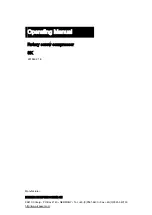
13–8–610 Page 33
oil and air filters. The condition of the separator can be
determined by pressure differential or by inspection.
Pressure Differential Gauging – The “CHANGE
SEPARATOR” message will flash when the pressure
differential across the oil separator reaches approxi-
mately 8 PSI (.6 Bar). Replace the oil separator ele-
ment at this time. If ignored, the unit will shut down and
the display will indicate shutdown and the change sep-
arator LED will be on when the pressure differential
reaches 15 PSI (1 Bar).
To measure the pressure differential, see “Pressure
and Temperature Digital Readouts” in Section 4, page
20. Simply subtract the downstream reading from the
upstream reading.
Using an oil separator element at ex-
cessive pressure differential can
cause damage to equipment. Replace
the separator when the “Change Sep-
arator” advisory appears.
A sudden drop of zero pressure differ-
ential or sudden heavy oil carryover
may indicate a ruptured element.
Inspection – After removal of separator element,
shine a light inside the element to reveal areas of heavy
dirt or varnish deposits or breaks (ruptures) in element
media.
Removal Of Oil Separator For Inspection Or Re-
placement:
Air/oil under pressure will cause
severe personal injury or death. Shut
down compressor, relieve system of
all pressure, disconnect, tag and
lockout power supply to the starter
before removing valves, caps, plugs,
fittings, bolts, and filters.
Compressor, air/oil reservoir, separa-
tion chamber and all piping and tub-
ing may be at high temperature during
and after operation.
1.
Be certain the unit is off and all system pressure
is relieved.
2.
Disconnect, tag and lockout the power supply to
the starter.
3.
Remove the screws holding the top plate to the
separator housing. Lift the top plate from the sep-
arator housing.
4.
Lift the separator from the separator housing.
5.
Inspect and/or replace the separator as neces-
sary. Be sure the o–ring is not damaged. Before
installing (or re–installing) any separator, apply
grease to the o–ring. Oil will be wiped off by the
chamfer and the ring could be damaged.
6.
Remove any gasket material adhering to the top
of the plate or separator housing, and install the
new gasket.
7.
Lower the separator into the housing and center
the separator on the chamfer. Press the separator
down into the housing. Do not use excessive
force as separator damage can occur.
8.
Place the spacer on the indent in the separator.
Seat the top plate to the separator, spacer and
separator housing. Install and tighten all cap
screws.
9.
Run the unit and check for leaks.
COMPRESSOR OIL SYSTEM CHECK – The follow-
ing readings are based on ambient temperature of
80
_
F (27
_
C) with the system in good condition. The
compressor should be at operating temperature at the
time of the checks. One–half hour of loaded operation
is usually sufficient to reach level–out operating tem-
peratures.
Air and Oil Discharge Temperature – 170
_
to 200
_
F
(77
_
to 93
_
C)– Read at the gauge on the instrument
panel or check with a thermometer at the discharge
housing.
Compressor Oil Inlet Temperature – 165
_
to 175
_
F
(74
_
to 79
_
C) – Install a tee at the oil filter outlet and
check with a thermometer.
Summary of Contents for ELECTRA-SCREW EDEQHH
Page 11: ...13 8 610 Page 3 200EDE797 Ref Drawing FIGURE 1 3 PACKAGE OIL LEVEL GAUGE SEPARATOR AIR FILTER...
Page 12: ...13 8 610 Page 4 202EDE797 Ref Drawing FIGURE 1 4 PACKAGE CONTROLLER STARTER BOX...
Page 15: ...13 8 610 Page 7 DECALS 206EAQ077 212EAQ077 218EAQ077 211EAQ077 207EAQ077...
Page 16: ...13 8 610 Page 8 DECALS 216EAQ077 217EAQ077 222EAQ077 221EAQ077 208EAQ077...
Page 33: ...13 8 610 Page 25 FIGURE 4 10 WIRING DIAGRAM FULL VOLTAGE DUAL CONTROL 204EDE546 Ref Drawing...
Page 34: ...13 8 610 Page 26 FIGURE 4 11 WIRING DIAGRAM WYE DELTA 205EDE546 Ref Drawing...
Page 53: ......













































